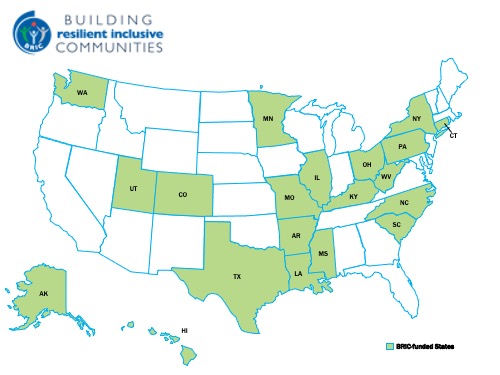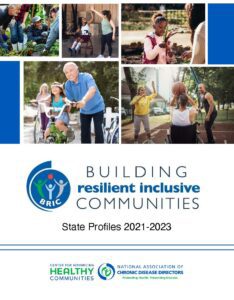Building Resilient Inclusive Communities (BRIC)
About BRIC
Though challenges surfaced due to the COVID-19 pandemic, potential opportunities to support states in addressing health risk factors and increasing overall community resiliency for chronic disease prevention arose. In collaboration with the Centers for Disease Control and Prevention’s (CDC) Division of Nutrition, Physical Activity, and Obesity (DNPAO) and the Division of Population Health (DPH), and a team of nationally recognized experts, NACDD worked with 20 State Health Departments and other organizations to implement the Building Resilient Inclusive Communities (BRIC) program from 2021-2024.
As part of the BRIC program, states engaged with more than 60 communities to address food and nutrition security, improve safe physical activity access, and reduce social isolation and loneliness through a policy, systems, and environmental change lens. Factors that impact health outcomes were integrated into the planning and implementation of all three strategy areas, in addition to accounting for the impact of the COVID-19 pandemic. States achieved a combination of the following outcomes:
Food and Nutrition Security
Outcomes
State Spotlights
• Collaborate with food policy council/coalition/task force on food and nutrition security for food banks, pantries, and/or feeding sites during the COVID-19 pandemic
– Provided mini-grants to 5 Hawai`i Food Banks to support healthier food for clients such as refrigeration and shelving. (Hawai`i County, HI)
• Efforts to increase number of food banks, pantries, or feeding sites in each community selected to adopt nutrition standards due to increase in demand due to the COVID-19 pandemic
– Partnered with Connecticut Foodshare to implement a series of trainings for food pantries/anchor organizations on improving food security through Supporting Wellness at Pantries and client choice implementation. (Connecticut)
• Efforts to support the increase in the number of people in communities who receive healthier foods distributed by food pantries, food banks, or other feeding sites, taking into consideration how demand has changed during the COVID-19 pandemic
• Efforts to increase number of places providing increased financial access to healthier foods
Safe Physical Activity Access
Outcomes
State Spotlights
Collaborate with task forces/coalitions that support safe physical activity for all during the COVID-19 pandemic
– Hosted NACDD’s Walkability Action Institute for up 9 Washington State communities. (Washington)
• Progress to support at least one local improvement plan that includes the potential assessment of local community design as it relates to improving safe access to physical activity (including number of federal, state, or local partners formally engaged) as well as how local demand had changed during the COVID-19 pandemic
– Lucas County Active Transportation Steering Committee conducted numerous community engagement activities to gain community input in developinging an Active Transportation Plan. (Lucas County, Ohio)
• Efforts to support at least two verified changes in the characteristics of each selected community that demonstrate walkability or increased safety for those most at risk for COVID-19 illness and death, taking into effect how local demand has changed during the COVID-19 pandemic
Social Connectedness
Outcomes
State Spotlights
• Collaborate with task forces/coalitions that support social connectedness for all during the COVID-19 pandemic
– Provided statewide training for Area Agencies on Aging on identifying sustainable and evidence-based programs and policy, systems and environmental change strategies. (Illinois)
• Efforts to implement new or improved community strategies that emphasize and integrate feasible and innovative social connectedness efforts for older adults at higher risk for severe illness from COVID-19; incorporation of existing networks of community health workers should be encouraged
– New York State Department of Health, New York State Office for the Aging, Association on Aging in New York, and DOROT partnered to develop the “Friendly Calls Volunteer Handbook” and training videos to reduce social isolation among older adults statewide. (New York)
• Efforts to implement at least two new or improved equitable Intergenerational Mentoring Programs in the community to foster healthy, ongoing, supportive relationships between older adults and youth
• Efforts to implement at least two new or improved programs for older adults that offer on-line and in-person educational, social, creative, and physical activities that encourage personal interactions, regular attendance, and community involvement working in collaboration with existing programs

- Alaska Division of Public Health
- Arkansas Department of Health
- Colorado Department of Public Health and Environment (Year 1 only)
- Connecticut Department of Public Health
- Hawaii State Department of Health
- Illinois Public Health Institute
- Kentucky Cabinet for Health and Family Services (Year 1 only)
- Louisiana Department of Health
- Minnesota Department of Health
- Missouri Department of Health and Senior Services through an agreement with the Prevention Research Center at Washington University in St. Louis
- Mississippi State Department of Health
- North Carolina Department of Health and Human Services
- New York State Department of Health/Health Research, Inc.
- Ohio Department of Health
- Pennsylvania Department of Health
- South Carolina Department of Health and Environmental Control
- Texas Department of State Health Services through an agreement with Feeding Texas
- Utah Department of Health
- Washington State Department of Health
- West Virginia Department of Health and Human Service



Mara Galic, MHSc, RD
Senior Program Manager
Joann Donnelly, MA, BCC, CSM
Public Health Consultant
Leah Rimkus, MPH, RD
Associate Director, Evaluation
National Technical Assistance Partnership
NACDD convened the National Technical Assistance Partnership, made up of CDC, NACDD, and subject matter experts, to address the specific needs of the states through training, technical assistance and support, and consultation.
Association of State Public Health Nutritionists
BRIC is a program of the Center for Advancing Healthy Communities.
| Outcomes | State Spotlights |
|---|---|
| • Collaborate with food policy council/coalition/task force on food and nutrition security for food banks, pantries, and/or feeding sites during the COVID-19 pandemic | – Provided mini-grants to 5 Hawai`i Food Banks to support healthier food for clients such as refrigeration and shelving. (Hawai`i County, HI) |
| • Efforts to increase number of food banks, pantries, or feeding sites in each community selected to adopt nutrition standards due to increase in demand due to the COVID-19 pandemic | – Partnered with Connecticut Foodshare to implement a series of trainings for food pantries/anchor organizations on improving food security through Supporting Wellness at Pantries and client choice implementation. (Connecticut) |
| • Efforts to support the increase in the number of people in communities who receive healthier foods distributed by food pantries, food banks, or other feeding sites, taking into consideration how demand has changed during the COVID-19 pandemic | |
| • Efforts to increase number of places providing increased financial access to healthier foods |
| Outcomes | State Spotlights |
|---|---|
| • Collaborate with task forces/coalitions that support safe physical activity for all during the COVID-19 pandemic | – Hosted NACDD’s Walkability Action Institute for up 9 Washington State communities. (Washington) |
| • Progress to support at least one local improvement plan that includes the potential assessment of local community design as it relates to improving safe access to physical activity (including number of federal, state, or local partners formally engaged) as well as how local demand had changed during the COVID-19 pandemic | – Lucas County Active Transportation Steering Committee conducted numerous community engagement activities to gain community input in developinging an Active Transportation Plan. (Lucas County, Ohio) |
| • Efforts to support at least two verified changes in the characteristics of each selected community that demonstrate walkability or increased safety for those most at risk for COVID-19 illness and death, taking into effect how local demand has changed during the COVID-19 pandemic |
| Outcomes | State Spotlights |
|---|---|
| • Collaborate with task forces/coalitions that support social connectedness for all during the COVID-19 pandemic | – Provided statewide training for Area Agencies on Aging on identifying sustainable and evidence-based programs and policy, systems and environmental change strategies. (Illinois) |
| • Efforts to implement new or improved community strategies that emphasize and integrate feasible and innovative social connectedness efforts for older adults at higher risk for severe illness from COVID-19; incorporation of existing networks of community health workers should be encouraged | – New York State Department of Health, New York State Office for the Aging, Association on Aging in New York, and DOROT partnered to develop the “Friendly Calls Volunteer Handbook” and training videos to reduce social isolation among older adults statewide. (New York) |
| • Efforts to implement at least two new or improved equitable Intergenerational Mentoring Programs in the community to foster healthy, ongoing, supportive relationships between older adults and youth | |
| • Efforts to implement at least two new or improved programs for older adults that offer on-line and in-person educational, social, creative, and physical activities that encourage personal interactions, regular attendance, and community involvement working in collaboration with existing programs | |

